Dinosaurs Reveal the Geographical Signature of an Evolutionary Radiation
Yesterday, Everything Dinosaur posted an article on the newly published scientific paper that examined how the Dinosauria radiated out from their suspected South American origins and came to dominate terrestrial ecosystems around the world. The research was conducted by scientists based at Reading University and their paper was published this week in the academic journal “Nature Ecology & Evolution”.
To read our article on this research: The Evolutionary Radiation of the Dinosauria Mapped.
Building on an Earlier Study
Building upon earlier research, the Reading University scientists believe that the dinosaurs were already in decline before the final coup de grâce that marked the end of the Cretaceous and the demise of the non-avian dinosaurs. The dinosaurs spread across the planet, but they began to run out of space to migrate into, becoming victims of their own success.
Everything Dinosaur has received special permission from the University to publish some of the images created by the researchers that plot the routes taken by various dinosaur species as they spread across the world.
The pictures (below), show six reconstructed paths from the dinosaurian root node (black circle) to the fossilised species (black square). The coloured circles represent the centroids of the reconstructed ancestral locations (these are used for visualisation purposes only and posterior distributions of estimated ancestral locations are used in all analyses). These maps help to demonstrate the conclusions drawn by the researchers. Take for example, the first image, that of the path of Rhoetosaurus (R. brownei). R. brownei was a sauropod, its fossils are found in eastern Australia and it lived some 170 million years ago.
The Evolutionary Path of Rhoetosaurus brownei
Picture credit: University of Reading (silhouette credit: Remes K, Ortega F, Fierro I, Joger U, Kosma R et al, silhouette represents Spinophorosaurus nigerensis)
The Evolutionary Path of Archaeopteryx lithographica is Plotted
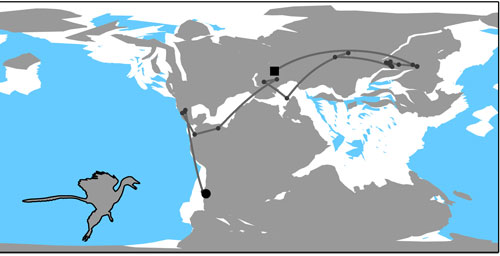
Picture credit: University of Reading (silhouette credit: Scott Hartman)
Studying the Dinosauria
Archaeopteryx lithographica lived around 150 million years ago, its fossils have been found in the limestone quarries of southern Germany. All the evolutionary paths that have been created by the researchers have been plotted onto geological age level palaeomaps from the time at which the fossil species is dated to (grey). All preceding age level palaeomaps are plotted in white.
Plotting the Path of the Ornithischian Dinosaur Stegosaurus stenops
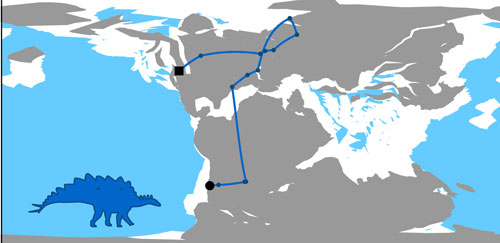
Picture credit: University of Reading (silhouette credit: Scott Hartman)
Like Archaeopteryx, Stegosaurus stenops fossils are associated with Upper Jurassic strata. However, this research suggests that unlike the Archaeopteryx lineage, which migrated into eastern Laurasia, the evolutionary path of S. stenops was oriented towards western Laurasia, fossils of this iconic armoured ornithischian being associated with the Morrison Formation of the western United States.
The Evolutionary Path of Andesaurus delgadoi is Plotted
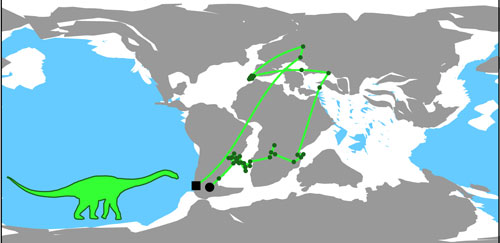
Picture credit: University of Reading (silhouette credit: T. Tischler, the silhouette represents the related titanosaurid Wintonotitan wattsi)
Late Cretaceous Migrations
The titanosaurid A. delgadoi lived some 97 million years ago (Cenomanian faunal stage of the Late Cretaceous). Note how the world map has changed in the illustrations, reflecting the change in the position of the continents. The known fossil evidence suggests that the majority of the titanosaurids were restricted to Gondwana for most of the Cretaceous species. Only in the very Late Cretaceous did a land bridge form, permitting these dinosaurs to migrate into North America.
Path of Dromaeosaurus albertensis
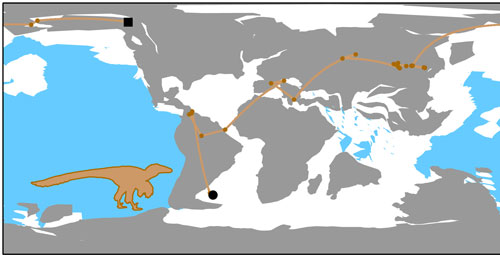
Picture credit: University of Reading (silhouette represents Dromaeosauroides bornholmensis known from Upper Cretaceous rocks from Denmark)
The researchers conclude that the dromaeosaurids associated with North America crossed over from northern Asia.
Last but not least, no evolutionary study mapping the spread of the dinosaurs would be complete without reference being made to the Tyrannosauroidea. The map below, shows the path plotted for Tyrannosaurus rex.
Plotting the Path for T. rex
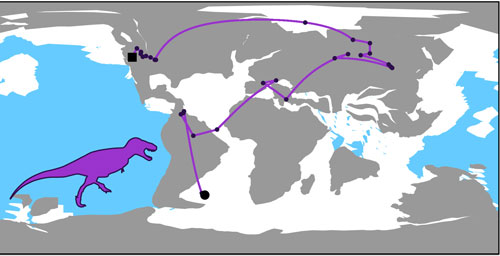
Picture credit: University of Reading
From their South America origins, this most famous of the Theropoda seems to have traversed Laurasia before heading westwards to become the dominant, apex predators in the Late Cretaceous (Laramidia and (most likely) Appalachia).
The authors of the scientific paper state that all silhouettes were downloaded from www.phylopicdotorg.
The scientific paper: “Dinosaurs Reveal the Geographical Signature of an Evolutionary Radiation” by Ciara O’Donovan, Andrew Meade and Chris Venditti published in Nature Ecology & Evolution.
Everything Dinosaur acknowledges the help of Reading University in the compilation of this article.
Visit the Everything Dinosaur website: Everything Dinosaur.


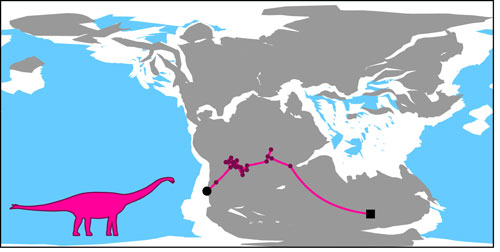




Leave A Comment